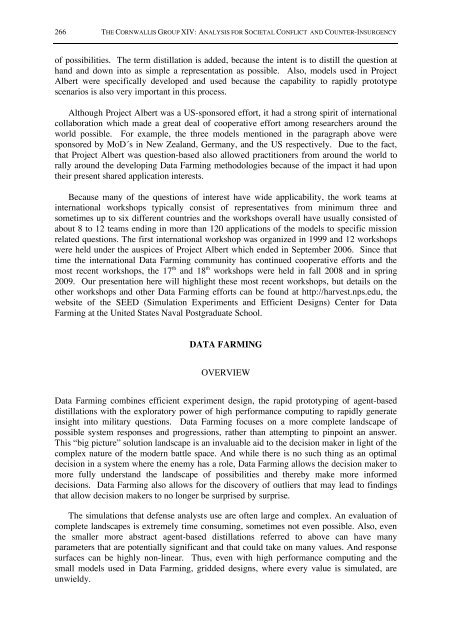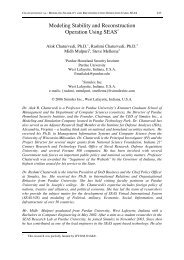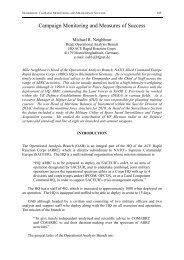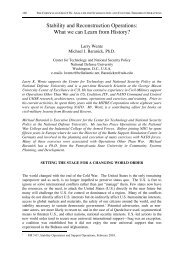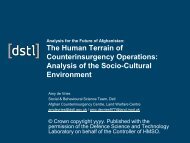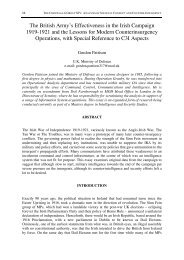Data Farming Around the World Overview - Cornwallis Group
Data Farming Around the World Overview - Cornwallis Group
Data Farming Around the World Overview - Cornwallis Group
- No tags were found...
Create successful ePaper yourself
Turn your PDF publications into a flip-book with our unique Google optimized e-Paper software.
266 THE CORNWALLIS GROUP XIV: ANALYSIS FOR SOCIETAL CONFLICT AND COUNTER-INSURGENCYof possibilities. The term distillation is added, because <strong>the</strong> intent is to distill <strong>the</strong> question athand and down into as simple a representation as possible. Also, models used in ProjectAlbert were specifically developed and used because <strong>the</strong> capability to rapidly prototypescenarios is also very important in this process.Although Project Albert was a US-sponsored effort, it had a strong spirit of internationalcollaboration which made a great deal of cooperative effort among researchers around <strong>the</strong>world possible. For example, <strong>the</strong> three models mentioned in <strong>the</strong> paragraph above weresponsored by MoD´s in New Zealand, Germany, and <strong>the</strong> US respectively. Due to <strong>the</strong> fact,that Project Albert was question-based also allowed practitioners from around <strong>the</strong> world torally around <strong>the</strong> developing <strong>Data</strong> <strong>Farming</strong> methodologies because of <strong>the</strong> impact it had upon<strong>the</strong>ir present shared application interests.Because many of <strong>the</strong> questions of interest have wide applicability, <strong>the</strong> work teams atinternational workshops typically consist of representatives from minimum three andsometimes up to six different countries and <strong>the</strong> workshops overall have usually consisted ofabout 8 to 12 teams ending in more than 120 applications of <strong>the</strong> models to specific missionrelated questions. The first international workshop was organized in 1999 and 12 workshopswere held under <strong>the</strong> auspices of Project Albert which ended in September 2006. Since thattime <strong>the</strong> international <strong>Data</strong> <strong>Farming</strong> community has continued cooperative efforts and <strong>the</strong>most recent workshops, <strong>the</strong> 17 th and 18 th workshops were held in fall 2008 and in spring2009. Our presentation here will highlight <strong>the</strong>se most recent workshops, but details on <strong>the</strong>o<strong>the</strong>r workshops and o<strong>the</strong>r <strong>Data</strong> <strong>Farming</strong> efforts can be found at http://harvest.nps.edu, <strong>the</strong>website of <strong>the</strong> SEED (Simulation Experiments and Efficient Designs) Center for <strong>Data</strong><strong>Farming</strong> at <strong>the</strong> United States Naval Postgraduate School.DATA FARMINGOVERVIEW<strong>Data</strong> <strong>Farming</strong> combines efficient experiment design, <strong>the</strong> rapid prototyping of agent-baseddistillations with <strong>the</strong> exploratory power of high performance computing to rapidly generateinsight into military questions. <strong>Data</strong> <strong>Farming</strong> focuses on a more complete landscape ofpossible system responses and progressions, ra<strong>the</strong>r than attempting to pinpoint an answer.This “big picture” solution landscape is an invaluable aid to <strong>the</strong> decision maker in light of <strong>the</strong>complex nature of <strong>the</strong> modern battle space. And while <strong>the</strong>re is no such thing as an optimaldecision in a system where <strong>the</strong> enemy has a role, <strong>Data</strong> <strong>Farming</strong> allows <strong>the</strong> decision maker tomore fully understand <strong>the</strong> landscape of possibilities and <strong>the</strong>reby make more informeddecisions. <strong>Data</strong> <strong>Farming</strong> also allows for <strong>the</strong> discovery of outliers that may lead to findingsthat allow decision makers to no longer be surprised by surprise.The simulations that defense analysts use are often large and complex. An evaluation ofcomplete landscapes is extremely time consuming, sometimes not even possible. Also, even<strong>the</strong> smaller more abstract agent-based distillations referred to above can have manyparameters that are potentially significant and that could take on many values. And responsesurfaces can be highly non-linear. Thus, even with high performance computing and <strong>the</strong>small models used in <strong>Data</strong> <strong>Farming</strong>, gridded designs, where every value is simulated, areunwieldy.


